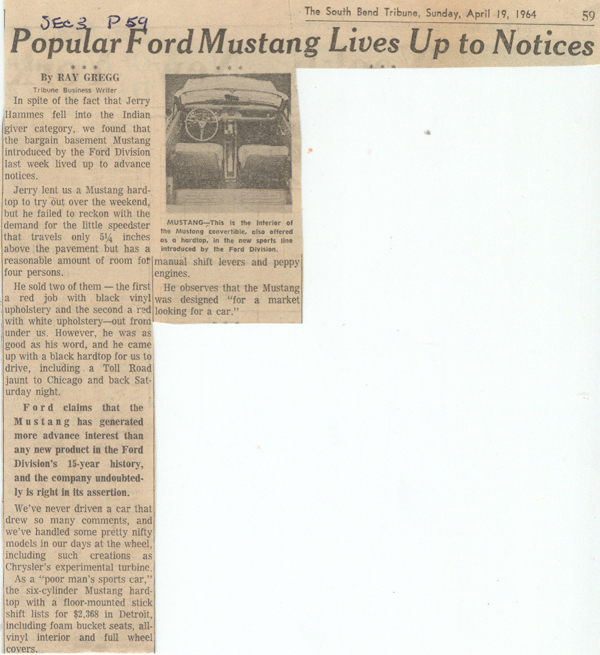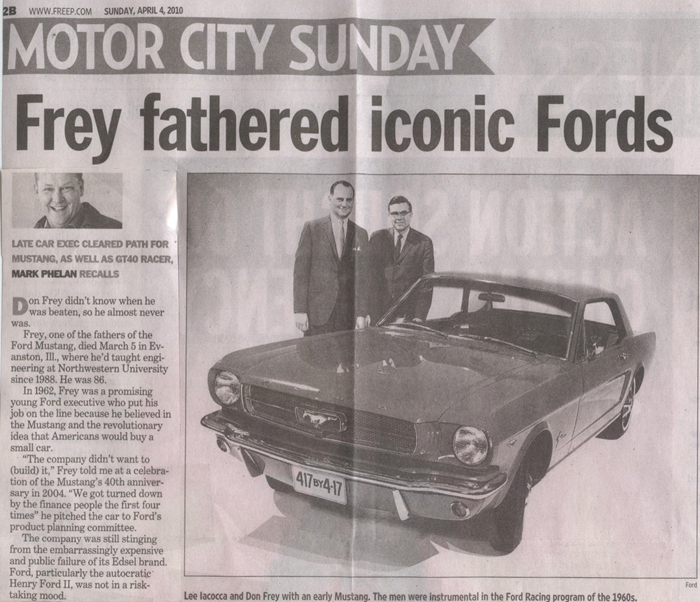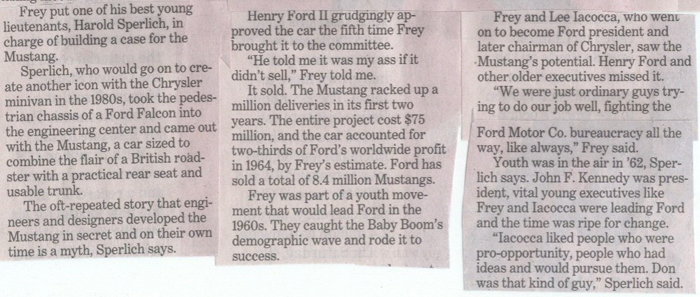![Jerry Hammes.com [Logo]](../../../images/logo.jpg)
|

|
1964 Ford Pace Car
[Back to topic list] [Back to 1964 Ford Pace Car Topic] Updated:2006-05-15 11:06:14 Original Pony Car Retrospective: 1964 Ford Mustang By ERIC PETERS  In 1964, Ford Motor Co. introduced the Mustang to the world. The company created a buzz by running TV ads the night before the car's unveiling at the World's Fair in New York, according to the company's web site. The first Mustangs sold at an average retail price of $2,812.00 Ford General Manager Lee Iacocca probably didn't fully realize just what he was about to tap into with his new low-cost "personal car," the 1964 Mustang -- sort of like Jed Clampett, who inadvertently struck oil while he was out huntin' coon. In the early 1960s, there was no "youth market" (as such) for automobiles -- and the term, "pony car" had yet to be coined. But Iacocca -- who had risen from obscurity in the hinterlands of Pennsylvania to lead the Ford division in a span of just five years -- somehow tapped into the post-war collective unconscious and saw the need for a new kind of car for the emerging market of young and restless twentysomethings -- the group that would later be called baby boomers. The parameters for what became the first Mustang were simple and straightforward. It was to be inexpensive to manufacture, with a unitized body and mostly off-the-shelf suspension and chassis components. It would use existing and already proven drivetrains borrowed from other Ford models; there would be no risky gambits on elaborate new technologies the market might not be ready for -- as GM had bravely (but ultimately unsuccessfully) tried with the radical for the day, rear-engined, air-cooled Chevy Corvair. The new car would be compact and light, seat four, be peppy and sporty, and have a starting price under $2,500. Riding on a 108-inch wheelbase and modified Ford Falcon chassis, the first-year Mustang met Iacocca's every specification. It was also an out-of-the-park home run -- with sales topping 670,000 units by the end of 1965. No car since then has equaled this feat. The initial run of Mustangs was offered in two basic bodystyles -- a notchback, hardtop coupe and two-plus-two convertible -- with a fastback coupe joining the lineup later in the model year. A plethora of optional equipment and trim levels were offered from the get-go. This was deliberate strategy, intended to let buyers more or less custom-order their car. Mustangs could be fitted out as luxury tourers, economical runners or tire-barking street machines. There was truly a Mustang for everyone -- from young single men to young at heart retirees who felt good cruising in their drop-top 'Stang. Like the VW Beetle, the car transcended class and economic strata; drivers who could afford far more expensive machinery bought them as eagerly as those who had to beg and borrow every dime for the down payment. The car's multiple personalities were also key to its long-term "legs." Because it appealed to a much broader audience than just young, single guys -- as was the case with Pontiac's GTO -- the Mustang was able to weather many a storm and survive long after the GTO and its kind had been felled by declining interest in one-dimensional muscle cars. A look at the Mustang's roster of available powertrains helps give one an idea of how different one Mustang might be from another under the skin. The standard coupe's engine was a boilerplate straight six very similar to the one used in the economy-oriented Falcon, initially displacing a modest 170 cubes -- and offering an equally modest 101 brake horsepower. This was for buyers who wanted a "just the basics" car. Next up was a small V-8, the "Challenger" 260 -- shared with the mid-sized Fairlane. This engine gave 164-hp and was a good compromise between economy and sportiness. As production ramped up, another engine became available -- the 289 CID "Hi-Po" V-8. This was the engine that began the frenzy and really put the 'Stang on the map as a performance car. The presence of the 289 V-8 was denoted by chrome call-outs on the front fenders and prominent dual exhaust tips out back. This engine featured a high-revving solid lifter camshaft, low-restriction dual exhaust and four-barrel carburetor. It provided the gumption to get the Mustang to 60 mph in about 7 seconds if you knew how to work the 4-speed -- and became the centerpiece of a new "GT" performance package that also included full instrumentation with tachometer, floor-mounted shifter (manual or three-speed Cruise-O-Matic auto), firm-ride suspension and special interior and exterior trim bits. That first 289 Hi-Po model was a big hit and became the leading edge of a "Total Performance" program from Ford that culminated, in the late 1960s and early 1970s, in fearsome big block-equipped Mustangs like the twin-carbed 428 Cobra Jet and Boss 429 Mustangs that were just a few bends of the rule book away from all-out race cars. In 1965, sales once again topped half-a-million units -- big numbers -- although they didn't quite equal that spectacular first-year run of 680,989. Still, the Mustang was enormously successful -- the 1960s equivalent of what the first SUV would be to later generations. Within three model years, GM would have two "pony cars" of its own to answer the Mustang's challenge -- the Pontiac Firebird and Chevy Camaro. Chrysler jumped into the ring, too -- with its E-Body Barracuda and Challenger coupes. Even frumpy AMC felt the need to get a Mustang fighter into circulation -- and ginned up the Javelin and AMX. By 1970, there were more than half-a-dozen Mustang imitators on the market -- each of them trying to horn in on the market the '64 Mustang single-handedly identified -- and arguably tapped into better than any of them. By 1975, all of them except the Camaro and Firebird would be gone -- victims of changing times and changing tastes they failed to adapt to. But the Mustang continued to evolve and so remained popular -- even when Ford took a huge risk and downsized (and down-powered) the car in 1974, shifting the emphasis back toward the original 1964 concept of economy with touches of sportiness rather than all-out performance. This move -- mocked at the time by enthusiasts -- enabled the car to make it through the bleak desert of the 1970s and eventually stage a huge comeback in the early 1980s, when the resurrected "Boss 5.0" Mustang GT became (once again) one of the hottest sporty cars on the road. The Mustang continued to slug it out with Chevy's Camaro and the Pontiac Firebird through the 1990s -- gaining ground by sticking with the proven formula of offering buyers multiple Mustangs to suit any need -- from family-friendly runabout to head-banging quarter-miler, with a wealth of sub-models (Saleen, Cobra R, SVO). Camaro and Firebird, meanwhile, became ever-more single-minded -- with horsepower and performance becoming the major (some critics say only) selling points by the mid-1990s. Unfortunately for GM, this cost the Chevy and Pontiac sales -- which dropped to an unsustainable low by the year 2000 that led to GM canceling production of the Mustang's last Detroit-built competition after the '02 season. This left the Mustang as the sole survivor of the era of its conception -- and as popular as ever following a hugely successful "retro-restyle" for 2005 that gave the young buyers of the 21st century a chance to enjoy an automotive experience very similar to the one their baby boomer parents got to more than 40 years ago. In a car called Mustang. 2006-     |
 |
 |
 |
 |
 |
 |
 |
 |